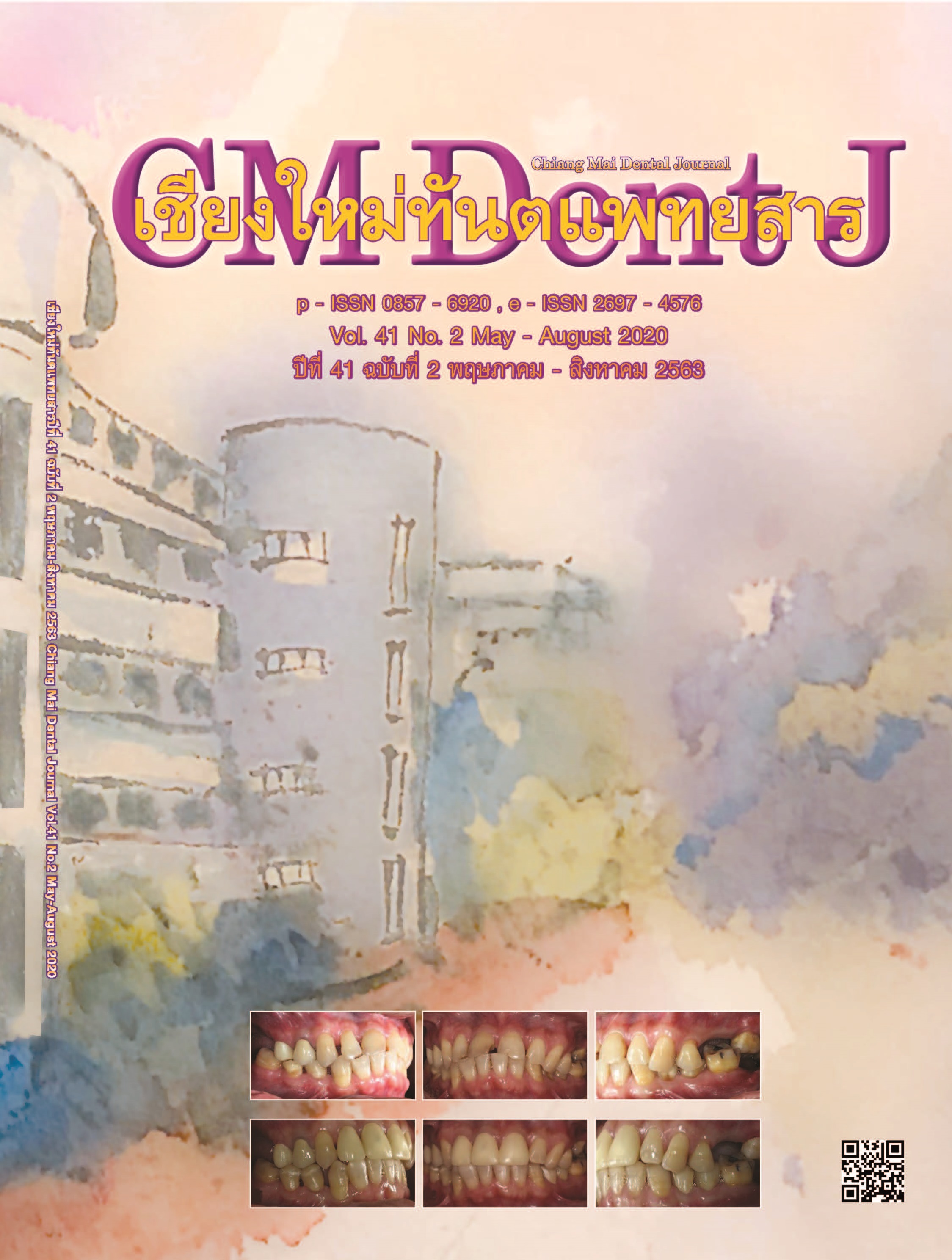Increasing Vertical Dimension with Indirect Resin Composite Onlay for Full Mouth Oral Rehabilitation
Main Article Content
Abstract
Diagnosis and treatment planning for full mouth rehabilitation in the patient with teeth wear and limited interocclusal space has been challenging. Gathering information and careful examination should be done for the correct diagnosis and treatment plan. One of the important treatment plans is the usage of appropriate restorative materials for patients. Generally, there are several techniques to increase the vertical dimension for patients ,for example temporary plate raise bite, splint, and resin composite onlay. This clinical case reported increasing vertical dimension by using indirect resin composite onlay bond with self-cure resin cement. Following 4-6 weeks after increased the vertical dimension, the restoration exhibited the acceptable function and esthetics. The result showed that most of restorations had good appearance and didn’t need to be repaired. The main advantage of this technique is the resin composite application which provide a strong and great esthetic outcome. Moreover, using resin composite with resin cement provide a good adhesion, high strength, and less marginal leakage. In conclusion, this technique can be one of a treatment of choice for increasing vertical dimension.
Article Details
References
Lee A, He LH, Lyons K, Swain MV. Tooth wear and wear investigations in dentistry. J Oral Rehabil 2012; 39(3): 217-225.
Brown KE. Reconstruction considerations for severe dental attrition. J Prosthet Dent 1980; 44(4): 384-388.
Pintado MR, Anderson GC, DeLong R, Douglas WH. Variation in tooth wear in young adults over a two-year period. J Prosthet Dent 1997; 77(3): 313-320.
Fava J, editors. Altering Vertical Dimension with Bonded Composite [monograph on the Internet]. Oral Health; 2015 [cited 2016 Nov 23]. Available from: https://www.oralhealthgroup.com/features/altering-vertical-dimension-bonded-composite/
Grippo JO, Simring M, Schreiner S. Attrition, abrasion, corrosion and abfraction revisited: a new perspective on tooth surface lesions. J Am Dent Assoc 2004; 135(8): 1109-1118.
Lussi A. Dental erosion: from diagnosis to therapy. 20th ed. Basel. Karger Medical and Scientific; 2006: 1-31.
Turner KA, Missirlian DM. Restoration of the extremely worn dentition. J Prosthet Dent 1984; 52(4): 467-474.
Wassell RW, Steele JG, Welsh G. Considerations when planning occlusal rehabilitation: a review of the literature. Int Dent J 1998; 48(6): 571-581.
Moreno‐Hay I, Okeson JP. Does altering the occlusal vertical dimension produce temporomandibular disorders? a literature review. J Oral Rehabil 2015; 42(11): 875-882.
Christensen J, Effect of occlusion-raising procedures on the chewing system. J Contemp Dent Pract 1970; 20: 233–238.
Carlsson GE, Ingervall B, Kocak G. Effect of increasing vertical dimension on the masticatory system in subjects with natural teeth. J Prosthet Dent 1979; 41: 284–289.
Dahl BL, Krogstad O. The effect of a partial bite raising splint on the occlusal face height. An x-ray cephalometric study in human adults. Acta Odontol Scand 1982; 40: 17–24.
Vailati F, Belser UC. Full-mouth adhesive rehabilitation of a severely eroded dentition: the three-step technique. Part 1. Int J Esthet Dent 2008; 3(1): 30-44.
Spreafico RC. Composite resin rehabilitation of eroded dentition in a bulimic patient: a case report. Int J Esthet Dent 2010; 5(1): 28-48.
Bahillo J, Jané L, Bortolotto T, Krejci I, Roig M. Full-mouth composite rehabilitation of a mixed erosion and attrition patient: A case report with v-shaped veneers and ultra-thin CAD/CAM composite overlays. Quintessence Int 2014; 45(9): 749-756.
Wassell RW, Barker D, Steele JG. Crowns and other extra-coronal restorations: try-in and cementation of crowns. Br Dent J 2002; 193(1): 23-26.
Wassell RW, Steele JG, Welsh G. Considerations when planning occlusal rehabilitation: a review of the literature. Int Dent J 1998; 48(6): 571-581.
Abduo J, Lyons K. Clinical considerations for increasing occlusal vertical dimension: a review. Aust Dent J 2012; 57(1): 2-10.
Fishman LS. Dental and skeletal relationships to attritional occlusion. Angle Orthod 1976; 46(1): 51–63.
Varrela J. Dimensional variation of craniofacial structures in relation to changing masticatory-functional demands. Eur J Orthod 1992; 14(1): 31–36.
Johansson A, Johansson AK, Omar R, Carlsson GE. Rehabilitation of the worn dentition. J Oral Rehabil 2008; 35(7): 548–566.
De Boever JA, Carlsson GE, Klineberg IJ. Need for occlusal therapy and prosthodontic treatment in the management of temporomandibular disorders. Part II: Tooth loss and prosthodontic treatment. J Oral Rehabil 2000; 27(5): 647–659.
Parker MH, Calverley MJ, Gardner FM, Gunderson RB. New guidelines for preparation taper. J Prosthodont 1993; 2(1): 61–66.
Goodacre CJ, Campagni WV, Aquilino SA. Tooth preparation for complete crowns: an art form based on scientific principles. J Prosthet Dent 2001; 85(4): 363–376.
Carlsson GE, Ingervall B, Kocak G. Effect of increasing vertical dimension on the masticatory system in subjects with natural teeth. J Prosthet Dent 1979; 41(3): 284–289.
Dahl BL, Krogstad O. The effect of a partial bite raising splint on the occlusal face height. An x-ray cephalometric study in human adults. Acta Odontol Scand 1982; 40(1): 17–24.
Dahl BL, Krogstad O. Long-term observations of an increased occlusal face height obtained by a combined orthodontic/prosthetic approach. J Oral Rehabil 1985; 12(2): 173–176.
Ormianer Z, Palty A. Altered vertical dimension of occlusion: a comparative retrospective pilot study of tooth- and implant-supported restorations. Int J Oral Maxillofac Implants 2009; 24(3): 497–501.
Dao TT, Feine JS, Lund JP. Can electrical stimulation be used to establish a physiologic occlusal position?. J Prosthet Dent 1988; 1; 60(4): 509-514.
Veloso L, Dias R, Messias A, Fonseca J, Nicolau P. Evaluation of condylar position by CBCT after static and dynamic registration in edentulous patients. Rev Port Estomatol Cir Maxilofac 2015; 1; 56(1): 9-17.
Piemjai M, Nakabayashi N. Direct tensile strength and characteristics of dentin restored with all-ceramic, resin-composite, and cast metal prostheses cemented with resin adhesives. Biomed Res Int 2015: 1-10.
Piemjai M, Thaveeratana A, Nakabayashi N. Marginal integrity between a prefabricated composite block and enamel, DEJ, and dentin. Am J Dent 2010; 23(5): 285-291.


